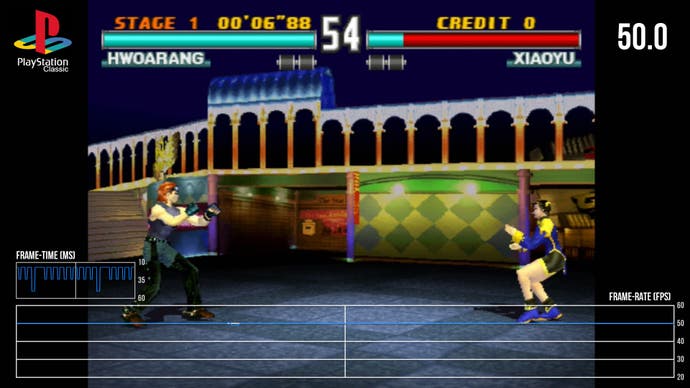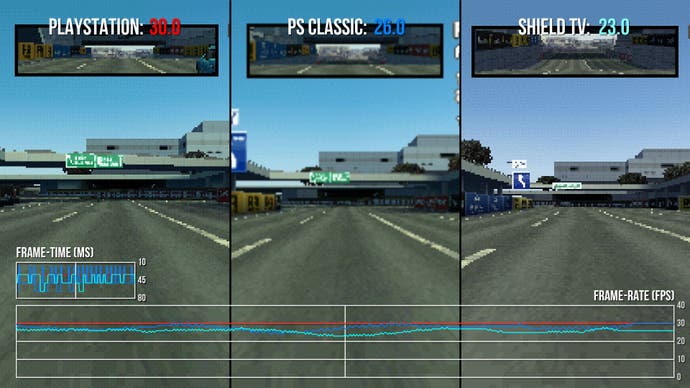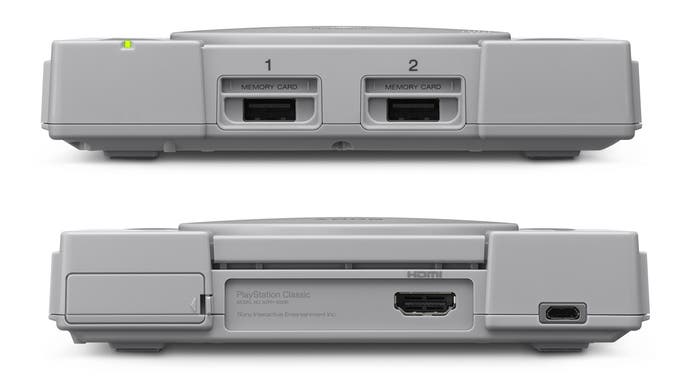PlayStation Classic review: the games are great but the emulation is really poor
A profound disappointment.
With its remarkable, varied game library, the original PlayStation stands as one of the best console platforms in gaming history. For Sony as a corporate entity, the PlayStation brand remains a key part of its lineup and one that has arguably saved the company at points during its long history. For gamers though, the original grey box represents an era of discovery and wonderful memories - a time when previously niche genres were given the chance to thrive the world over and well-worn genres were given new life in the transition to 3D.
A product like the PlayStation Classic seems like a smart move then. Package 20 great PlayStation games in a small plug and play replica of the PlayStation with two controllers and you have the recipe for a great product, a celebration of one of the most important gaming devices of all-time. Nintendo has found great success with its Classic mini line of micro-consoles so why not Sony? Unfortunately, as you may already know, this particular story doesn't have a happy ending.
The PlayStation Classic falls short of expectations in many key areas, but while the major deficiencies of the product have already been discussed, I wanted to explain in more detail what went wrong, and why the PS Classic falls short - and it begins with the already high standard of PS1 emulation that Sony has championed in past PlayStation hardware.
The PlayStation 2 includes both the hardware and software necessary to play original PS1 games at native resolution while introducing optional enhancements such as faster loading and texture smoothing. The PSP, Sony's first handheld gaming console, also received support for PS1 games in 2006 and thanks to the shared MIPS CPU architecture, only partial emulation is required - many of the instructions can run natively on the PSP CPU - a feature the Vita would later make use of when running PlayStation software as well. Even the PS3 received full support for PlayStation games with a decent software emulator.
The bar is set then, with the expectation of excellent, accurate emulated support - which unfortunately the Classic fails to match. In fact, I'd say it's quite possibly the worst piece of console hardware Sony has ever released, and that's such a shame, especially as superficially, it looks like a great piece of kit. This new unit is housed in a replica of the original design with three fully working buttons and a controller in the design of the original non-DualShock pad. In terms of software, the 20 games featured on the system sparked a lot of debate over what should be included with a PlayStation Classic and, sure, it's missing a lot of games I'd have liked to see but I feel that it's still an interesting collection and most of the titles are worthy inclusions.
On the inside, the Classic differs greatly from original hardware, as you'd expect. The system is powered by a MediaTek system-on-chip pairing an entry-level ARM Cortex A35 quad-core cluster with an integrated PowerVR GE8300 GPU, 1GB of DDR3 memory and 16GB of flash storage. This setup runs rings around the original PlayStation and should offer more than enough power to emulate the original console with ease. The problem is, it doesn't.
From the moment you first power on the unit, its limitations start to become evident - though I must admit that the actual front-end is rather attractive. The startup screen features the familiar PlayStation bootup sound followed by a menu based on the original memory card/CD player menu included with early models of the PlayStation. A carousel of games adorns the centre of the screen - but then you enter the settings menu and realise that there are basically no settings to adjust. For starters, the PS Classic is limited to 720p output. It doesn't feature any filters, scanlines or adjustments to improve video output and it's locked to RGB full range - yep, if you're using the Classic in an RGB limited setup, you'll need to adjust your display to use the appropriate setting which can be a hassle if you're using RGB limited with other devices.
When you first fire up a game, display issues are immediately evident. Image quality is remarkably blurry as a result of poor scaling and heavy filtering. Pixel art games such as Rayman should appear crisp and clean but are instead reduced to a blurry mess. The emulator is configured to use some sort of MDEC filtering, resulting in less dithered, pixelated playback - something that could possibly be considered a positive, but most games just wind up looking muddy. When you couple this with the typically blurry upscaling of 720p content you get on most modern flat panel TVs, the result is poor image quality that does the collection of games no favours.

At its core, the PlayStation Classic is powered by open source software as opposed to an in-house solution - and in theory at least, this could be a great thing. Over the past few years, the PlayStation emulation scene has continued to evolve with some huge advancements in rendering. PGXP, for instance, can eliminate texture warping in many games resulting in clean, stable image quality that was previously impossible on the PlayStation. The Classic, however, makes use of PCSX ReARMed - a widely available ARM port of the PCSX emulator.
The accuracy of ReARMed isn't amazing but for lower powered ARM devices, it does a reasonable job and can be a good choice - but using it isn't a particularly great idea for a retail product like the Classic. Emulation in general appears fine but there are a few minor glitches here and there which surprised me - and there's the sense that little effort has been made to correct issues with the emulation. Even audio has problems - Final Fantasy 7's music slows down at points, while Ridge Racer Type 4 doesn't handle reverb properly: you get the impression that the effect is flipped on and off during gameplay in a rather unpleasant manner - something that doesn't happen on original hardware.
The second major issue lies in the game selection itself - "as previously reported, nine of the 20 games are European PAL versions. If you're not familiar with PAL, in simple terms, it's basically the European broadcast standard established decades ago. PAL delivers a higher resolution than the NTSC standard used elsewhere, while updating at 50Hz instead of the 60Hz. It's not something you need to think about in the era of HDMI but for European gamers, this was a serious problem back in the day. You see, games developed in Japan or the States were often designed to run at 60Hz and not properly optimized for 50Hz PAL displays. They didn't take advantage of PAL's increased resolution resulting in a squished, letterboxed image and game speed was often 16.7 per cent slower while video sequences delivered extra judder.
As expected, all nine of the included PAL titles run slower (though the letterboxing is eliminated) but the problem is exacerbated on PlayStation Classic. The reason? The 50Hz gameplay of these titles is dropped into the Classic's 60Hz output resulting in significant judder. So, while PAL games often played slowly on an original 50Hz television, frame delivery was at least consistent, which is not the case here. And this leads us to problem three - the most serious issue of all. Performance is poor and this is a tricky one to discuss as it's so variable across the run of play.

Take Tekken 3. It's clear that the game runs at a slower speed owing to its PAL origins - with extra stutter introduced via duplicate frames caused by the 50Hz to 60Hz conversion. If we observe the game running on a real PlayStation, however, it's a locked 60fps and moves at a much faster pace - and this is the way Tekken 3 should play. For good measure, I also loaded up the game using PCSX ReARMed within RetroArch on the Nvidia Shield TV. This Android-based system uses Tegra X1 - hardware that outperforms the PS Classic by a large margin. The thing is - Tekken 3 doesn't exactly run at full speed on the Shield during gameplay when using the ReARMed core. I played around with various settings but ReARMed wasn't quite able to reach a locked 60fps. With that in mind, perhaps the 50hz version was selected to work around this issue? Adding insult to injury is that the PSP handheld - and by extension, PlayStation Vita - runs circles around the PS Classic and Shield TV in performance terms, while supporting native 240p (or 480i in the case of Tekken 3) output when using video out, though 480p is also available.
Most of the other PAL games aren't targeting high frame-rates, and this is where things get worse. Cool Boarders 2 shows the same issue we noticed with Tekken 3 - not only are there typical frame-time dips as a result of the 50Hz to 60Hz conversion but there are additional missed frames along the way as well and this feels much worse at a lower frame-rate. It goes doubly so for Grand Theft Auto - which is seemingly a 20fps game in its NTSC form, brought down to just 17fps on the PS Classic. The low frame-rate and new frame-pacing issues all produce something that feels borderline unplayable. The rest of the PAL games exhibit similar problems and honestly, this just isn't acceptable. The performance on the Classic gives the impression that these games run a lot worse than you might remember when they most certainly did not, and this may negativity colour the opinions people hold on these games.
It wouldn't be too bad if the rest of the NTSC games ran properly but sadly, they do not. Ridge Racer Type 4 is one of my favorite games in the collection and on original hardware, it delivers a very steady 30 frames per second. So how does the Classic fare? Well, unfortunately, it's terrible. There are two issues here - firstly, the frame-time isn't consistent even though we're playing an NTSC game. The frame-times bounce between 16ms, 33ms and 50ms constantly. Even worse, there is actual slowdown on the PS Classic that was not present on original hardware. It's remarkably jerky to the point where a lot of the fun is sucked right out. When you couple poor performance with bad sound and blurry image quality, it's not a pretty picture. Another issue I noticed is the game's menu system. It uses interlaced output on original hardware and seems to run incorrectly on the Classic. It's dropping frames and appears choppy in comparison - not a huge deal, mind you, but another strike against the Classic. Once again, PSP, Vita and PlayStation TV deliver an experience nearly identical to original hardware.

Even games that are designed to run at a constant 60 frames per second, like Rayman, fail to do so. It's close but there is a constant hitch that appears every second or so that creates a constant, highly distracting stutter. The original PlayStation, by comparison, has little issue holding 60fps in this game. This is one of my favorite games on the collection so it's really crushing to see this issue. I think you're starting to get the picture then - no matter which game you select, performance is never as fluid as the original console or any other emulation solution Sony has delivered in the past.
This is really the main problem - the PlayStation Classic paints an overly negative picture of these games. Frame-rates are lower and less consistent, image quality is blurry and there are glitches. Input latency, while acceptable, remains higher than original hardware. The inclusion of PAL games remains totally baffling - and the idea that the emulator isn't fast enough to run the NTSC originals is the only explanation I can come up with here for this bizarre state of affairs. It's such a shame because there are positives here. The front-end is great - you have virtual memory cards available for each and every game and it features a save state system that allows you to jump back into any game at the point you left off. The basics are there but the choice of emulation software and the poor performance level ruin the experience.
So where does that leave us then? Well, if you want to play original PlayStation games properly, I'd recommend steering clear of the PS Classic - even if you aren't interested in buying original hardware, Sony has plenty of superior solutions ready to go. A PlayStation 3 is a great choice and shouldn't cost much more than a PS Classic. The PSP and Vita are also excellent for enjoying PS1 games - the PSP Go, in fact, is my favorite portable PS1 device since it can be used as a portable or connected to an analogue TV where it delivers native 240p and 480i output, while pairing with a DualShock 3. It's a great little device. The Vita TV is another option but these days, prices are shooting up and the quality of the upscaling leaves a lot to be desired.

Looking back, it's funny to revisit the original concerns over this product - everyone was focused on the library but that's become the least of its problems and honestly, I don't think the selection of games is half bad. The big titles included are absolutely worthy but some of the other titles deserve attention as well. I've already mentioned Rayman and I feel it doesn't quite get the respect it deserves. It's a brilliant, beautiful game with smooth performance and challenging gameplay. Mr Driller is another one. While I prefer its sequel, Mr Driller G, the original is still a classic puzzle game. It's definitely worth playing and the same goes for Super Puzzle Fighter 2 Turbo.
Intelligent Qube is another one that's proving rather interesting - this is one that I missed back in the day but it's one of the best performing games on the Classic and it's rather addictive. The original Oddworld is also included here as well and holds up brilliantly. Even games like Battle Arena Toshinden - which is not especially good - make sense in terms of PlayStation history as it was a key title in the launch line-up.
If you're able to overlook the technical problems and just enjoy the games, there is still fun to be had here. Games like Oddworld, Final Fantasy 7 and Mr Driller all play well enough in a pinch. It's just that there are so many better ways to enjoy PS1 games. This isn't something I would ever replace my collection with - but these little micro consoles can be a fun way to revisit these games with minimal setup. It's the kind of thing you can pack on holiday for those rainy days - but the results here simply aren't good enough to justify even that much and it's still difficult to avoid the sense that nowhere near enough care and attention went into this one. What could have been a brilliant celebration of a classic console is instead a profound disappointment and that's especially surprising bearing in mind how well Sony has executed PS1 emulation in the past.


